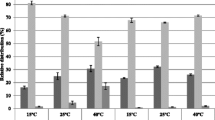Abstract
The cellular fatty acid composition ofPlanococcus halophilus NRCC 14033 grown at different temperatures and salt concentrations was studied. Increase of the temperature or salt concentration in the growth medium resulted in an increase of saturated fatty acid content with a concomitant decrease of branched-chain acids. This result suggested, for this bacterium, phenotypic adaptation to changes in both temperature and salt concentration in the natural environment.
Similar content being viewed by others
Literature Cited
Cronan JE, Gelman EP (1975) Physical properties of membrane lipids. Biological relevance and regulation. Bacteriol Rev 39:232–256
Drucker DB, Owen I (1973) Chemotaxonomic fatty acid fingerprints of bacteria growth with and without aeration. Can J Microbiol 19:247–250
Hanna K, Bengis-Garber C, Kushner DJ, Kogut M, Kates M (1984) The effect of salt concentration on the phospholipid and fatty acid composition of the moderate halophileVibrio costicola. Can J Microbiol 30:669–675
Hara H, Hyono A, Kuriyama S, Yano I, Masui M (1980) ESR studies on the membrane properties of a moderately halophilic bacterium. II. Effect of extreme growth conditions on liposome properties. J Biochem 88:1275–1282
Hiramatsu T, Ohno Y, Hara H, Yano I, Masui M (1980) Effects of NaCl concentration on the envelope components in a moderately halophilic bacterium,Pseudomonas halosaccharolytica. In: Morishita M, Masui M (eds) Saline environments: proceedings of the Japanese conference on halophilic microbiology. Kyoto: Nakanishi, pp 189–199
Hyono A, Kuriyama S, Hara H, Yano I, Masui M (1979) Thick viscous structures in the lipid membrane of a moderately halophilic gram-negative bacterium. FEBS Lett 103:192–196
Komaratat P, Kates M (1975) The lipid composition of a halotolerant species ofStaphylococcus epidermidis. Biochim Biophys Acta 398:464–484
Lanyi JK (1974) Salt-dependent properties of proteins from extremely halophilic bacteria. Bacteriol Rev 38:272–290
McElhaney RN (1976) The biological significance of alterations in the fatty acid composition of microbial membrane lipids in response to changes in environmental temperature. In: Heinrich MR (ed) Extreme environments: mechanisms of microbial adaptation. New York: Academic Press, pp 255–281
Melchior DL (1982) Lipid phase transitions and regulation of membrane fluidity in prokaryotes. In: Razin S, Rottem S (eds) Current topics in membranes and transport. New York: Academic Press, pp 263–316
Monteoliva-Sanchez M, Ramos-Cormenzana A (1986) Effect of growth temperature and salt concentration on the fatty acid composition ofFlavobacterium halmephilum CCM 2831. FEMS Microbiol Lett 33:51–54
Novitsky TJ, Kushner DJ (1976)Planococcus halophilus sp. nov., a facultatively halophilic coccus. Int J Syst Bacteriol 26:53–57
Ohno Y, Yano I, Masui M (1979) Effect of NaCl concentration and temperature on the phospholipid and fatty acid composition of a moderately halophilic bacteriumPseudomonas halosaccharolytica. J Biochem 85:413–421
Oshima M, Miyagawa A (1974) Comparative studies on the fatty acid composition of moderately and extremely thermophilic bacteria. Lipids 9:476–480
Rilfors L, Wieslander A, Stahl S (1978) Lipid and protein composition of membrane ofBacillus megaterium variants in the temperature range 5 to 70°C. J Bacteriol 135:1043–1052
Souza KA, Kostiw LL, Tyson BJ (1974) Alterations in normal fatty acid composition in a temperature-sensitive mutant of a thermophilic bacillus. Arch Microbiol 97:89–102
Subov NN (1931) Oceanographical tables. Moscow: USSR Oceanographical Institute, Hydrometeorological Communications
Ventosa A, Quesada E, Rodriguez-Valera F, Ruiz-Berraquero F, Ramos-Cormenzana A (1982) Numerical Taxonomy of moderately halophilic gram-negative rods. J Gen Microbiol 128:1959–1968
Wakil SJ (1970) Lipid metabolism. New York: Academic Press
Yano I, Saito K, Furukawa Y, Kusunose M (1972) Structural analysis of molecular species of nocardiomycolic acids fromNocardia erythropolis by the combined systems of gas-chromatography and mass-spectrometry. FEBS Lett 21:215–219
Yao M, Walker HW, Lillard DA (1970) Fatty acid from vegetative cells and spores ofBacillus stearothermophilus. J Bacteriol 102:877–878
Author information
Authors and Affiliations
Rights and permissions
About this article
Cite this article
Monteoliva-Sanchez, M., Ramos-Cormenzana, A. Cellular fatty acid composition ofPlanococcus halophilus NRCC 14033 as affected by growth temperature and salt concentration. Current Microbiology 15, 133–136 (1987). https://doi.org/10.1007/BF01577260
Issue Date:
DOI: https://doi.org/10.1007/BF01577260




